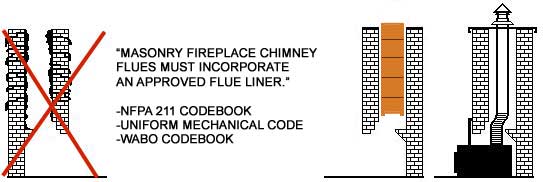
The Chimney Sweep Online Fireplace, Woodstove, Gas Stove and Barbecue Shop

The Chimney Sweep Online Fireplace, Woodstove, Gas Stove and Barbecue Shop

CODE VIOLATION: As wood exhaust passes through an unlined chimney, liquid creosote condenses onto the inner brick surfaces and attacks the bonding agent in the unprotected mortar joints. Eventually, the mortar bond is destroyed, allowing the liquid to penetrate the mortar joints. In worst cases, this highly combustible liquid can soak all the way through to the outside of the chimney structure. This soaked-in creosote can't be removed, and will likely ignite in the event of a chimney fire, resulting in open flames on the outside of the chimney. ====================================== Gas exhaust contains a mixture of water and nitric acid, which also attacks unprotected mortar joints, eventually dissolving the binder. When the binder is gone, the water saturates the mortar, turning it to mush. The water saturates surrounding walls, causing dry-rot. Eventually, the chimney structure collapses. | CODE REQUIREMENT: Fix #1: The chimney structure is torn down and rebuilt with the required pumice or terra cotta liner. Fix #2: A wood or gas fireplace insert is installed, with a UL listed, stainless steel flue liner, the same diameter as the exhaust opening on the insert. A sealer plate at the top of the chimney creates dead-air insulation. Approved insulation may be added if warmer flue temperatures are needed. A top clamp, storm collar and rain cap complete the installation. Flexible stainless pipe is most often used for wood fireplace insert installations, as the flex is easier to snake through the damper area and any offsets in the chimney above. ====================================== For gas inserts, UL listed aluminum flex liner is used in place of stainless steel, due to its resistance to both water damage and nitric acid corrosion. Water-soaked mortar joints will often dry out and resolidify after a gas flue has been relined. |
THE BOTTOM LINE: NEVER VENT INTO AN UNLINED CHIMNEY! For more info about installing a stainless liner, click here.
| |